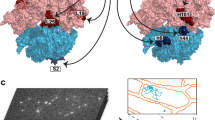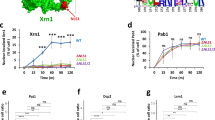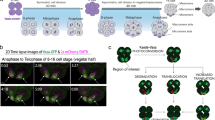Abstract
MESSENGER RNA (mRNA) in the cytoplasm of eukaryotic cells constitutes a small fraction of the total RNA synthesised in the nucleus1. This mRNA seems to be selected from the heterogeneous nuclear RNA (hnRNA) and transported to the cytoplasm where it decays much less rapidly than the hnRNA, which decays in the nucleus. In sea urchin embryos about 10% of the total RNA synthesised in the nucleus becomes cytoplasmic mRNA which decays 10 times less rapidly than the hnRNA. In L cells 2% of the RNA is transported and it decays 50 times less rapidly than hnRNA3. Several proposed models implicate ribosomes or ribosomal subunits in mRNA transport or decay4–6, and we have tested these possibilities in sea urchin embryos using pactamycin to inhibit the association of ribosomes with mRNA7 and precursor pool techniques worked out in this laboratory for measuring RNA metabolism2. The results show that neither synthesis, transport nor decay of mRNA depend on or are regulated by concurrent protein synthesis.
This is a preview of subscription content, access via your institution
Access options
Subscribe to this journal
Receive 51 print issues and online access
$199.00 per year
only $3.90 per issue
Buy this article
- Purchase on Springer Link
- Instant access to full article PDF
Prices may be subject to local taxes which are calculated during checkout
Similar content being viewed by others
References
Harris, H., Nucleus and cytoplasm (Clarendon, Oxford, 1968).
Brandhorst, B. P., and Humphreys, T., Biochemistry, 10, 877–881 (1971); J. Cell Biol., 53, 474–482 (1972).
Brandhorst, B. P., and McConkey, E., J. molec. Biol., 85, 451–463 (1974).
Harris, H., Sidebottom, E., Grace, D. M., and Bramwell, M. E., J. Cell Sci., 4, 499–525 (1969).
Sheiness, D., and Darnell, J. E., Nature new Biol., 241, 265–268 (1973).
Sussman, M., Nature, 225, 1245–1246 (1970).
Lodish, H. F., Housman, D., and Jacobsen, M., Biochemistry, 10, 2348–2356 (1971).
Kappen, L. S., Suzuki, H., and Goldberg, I. H., Proc. natn. Acad. Sci. U.S.A., 70, 22–26 (1973).
Blobel, G., Proc. natn. Acad. Sci. U.S.A., 70, 924–928 (1973).
Bryan, R. N., and Hayashi, M., Nature, 244, 271–274 (1973).
Author information
Authors and Affiliations
Rights and permissions
About this article
Cite this article
DUNCAN, R., DOWER, W. & HUMPHREYS, T. Normal synthesis, transport and decay of mRNA in the absence of its translation. Nature 253, 751–753 (1975). https://doi.org/10.1038/253751a0
Received:
Revised:
Published:
Issue Date:
DOI: https://doi.org/10.1038/253751a0
Comments
By submitting a comment you agree to abide by our Terms and Community Guidelines. If you find something abusive or that does not comply with our terms or guidelines please flag it as inappropriate.



